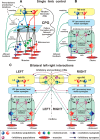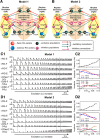Organization of the Mammalian Locomotor CPG: Review of Computational Model and Circuit Architectures Based on Genetically Identified Spinal Interneurons(1,2,3)
- PMID: 26478909
- PMCID: PMC4603253
- DOI: 10.1523/ENEURO.0069-15.2015
Organization of the Mammalian Locomotor CPG: Review of Computational Model and Circuit Architectures Based on Genetically Identified Spinal Interneurons(1,2,3)
Abstract
The organization of neural circuits that form the locomotor central pattern generator (CPG) and provide flexor-extensor and left-right coordination of neuronal activity remains largely unknown. However, significant progress has been made in the molecular/genetic identification of several types of spinal interneurons, including V0 (V0D and V0V subtypes), V1, V2a, V2b, V3, and Shox2, among others. The possible functional roles of these interneurons can be suggested from changes in the locomotor pattern generated in mutant mice lacking particular neuron types. Computational modeling of spinal circuits may complement these studies by bringing together data from different experimental studies and proposing the possible connectivity of these interneurons that may define rhythm generation, flexor-extensor interactions on each side of the cord, and commissural interactions between left and right circuits. This review focuses on the analysis of potential architectures of spinal circuits that can reproduce recent results and suggest common explanations for a series of experimental data on genetically identified spinal interneurons, including the consequences of their genetic ablation, and provides important insights into the organization of the spinal CPG and neural control of locomotion.
Keywords: central pattern generator; computational modeling; flexor–extensor coordination; genetically identified neurons; left–right coordination; locomotion; spinal cord.
Conflict of interest statement
The authors declare no competing financial interests.
Figures











Similar articles
-
Organization of left-right coordination of neuronal activity in the mammalian spinal cord: Insights from computational modelling.J Physiol. 2015 Jun 1;593(11):2403-26. doi: 10.1113/JP270121. J Physiol. 2015. PMID: 25820677 Free PMC article.
-
Organization of flexor-extensor interactions in the mammalian spinal cord: insights from computational modelling.J Physiol. 2016 Nov 1;594(21):6117-6131. doi: 10.1113/JP272437. Epub 2016 Jul 21. J Physiol. 2016. PMID: 27292055 Free PMC article.
-
Central control of interlimb coordination and speed-dependent gait expression in quadrupeds.J Physiol. 2016 Dec 1;594(23):6947-6967. doi: 10.1113/JP272787. Epub 2016 Nov 8. J Physiol. 2016. PMID: 27633893 Free PMC article.
-
Locomotor circuits in the mammalian spinal cord.Annu Rev Neurosci. 2006;29:279-306. doi: 10.1146/annurev.neuro.29.051605.112910. Annu Rev Neurosci. 2006. PMID: 16776587 Review.
-
Organization of mammalian locomotor rhythm and pattern generation.Brain Res Rev. 2008 Jan;57(1):134-46. doi: 10.1016/j.brainresrev.2007.08.006. Epub 2007 Sep 5. Brain Res Rev. 2008. PMID: 17936363 Free PMC article. Review.
Cited by
-
Roles of Mono- and Bi-articular Muscles in Human Limbs: Two-joint Link Model and Applications.Integr Org Biol. 2022 Nov 22;4(1):obac042. doi: 10.1093/iob/obac042. eCollection 2022. Integr Org Biol. 2022. PMID: 36441608 Free PMC article. Review.
-
From decision to action: Detailed modelling of frog tadpoles reveals neuronal mechanisms of decision-making and reproduces unpredictable swimming movements in response to sensory signals.PLoS Comput Biol. 2021 Dec 13;17(12):e1009654. doi: 10.1371/journal.pcbi.1009654. eCollection 2021 Dec. PLoS Comput Biol. 2021. PMID: 34898604 Free PMC article.
-
Cerebellar contribution to locomotor behavior: A neurodevelopmental perspective.Neurobiol Learn Mem. 2019 Nov;165:106861. doi: 10.1016/j.nlm.2018.04.016. Epub 2018 Apr 30. Neurobiol Learn Mem. 2019. PMID: 29723669 Free PMC article. Review.
-
Emergence of Different Gaits in Infancy: Relationship Between Developing Neural Circuitries and Changing Biomechanics.Front Bioeng Biotechnol. 2020 May 19;8:473. doi: 10.3389/fbioe.2020.00473. eCollection 2020. Front Bioeng Biotechnol. 2020. PMID: 32509753 Free PMC article. Review.
-
Spinal Control of Locomotion: Individual Neurons, Their Circuits and Functions.Front Physiol. 2018 Jun 25;9:784. doi: 10.3389/fphys.2018.00784. eCollection 2018. Front Physiol. 2018. PMID: 29988534 Free PMC article. Review.
References
Publication types
Grants and funding
LinkOut - more resources
Full Text Sources
Other Literature Sources
